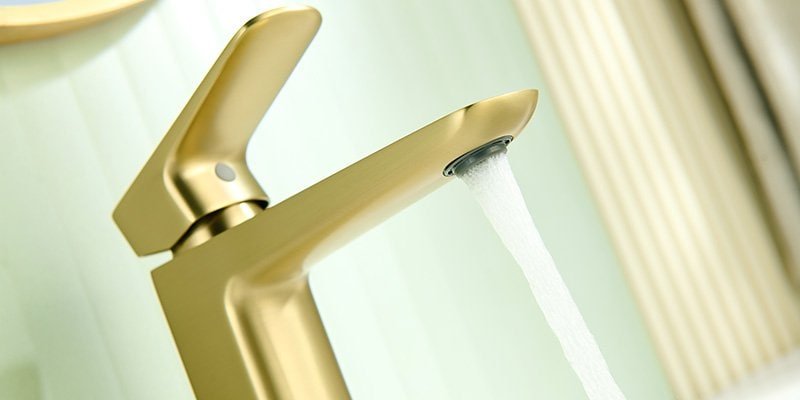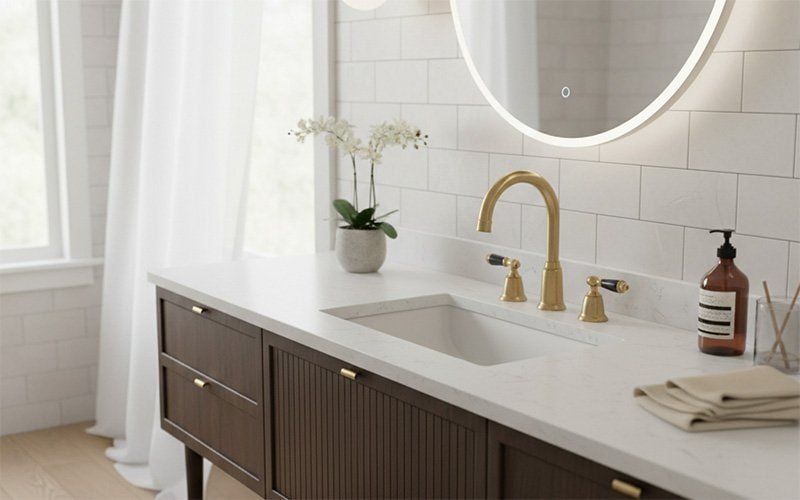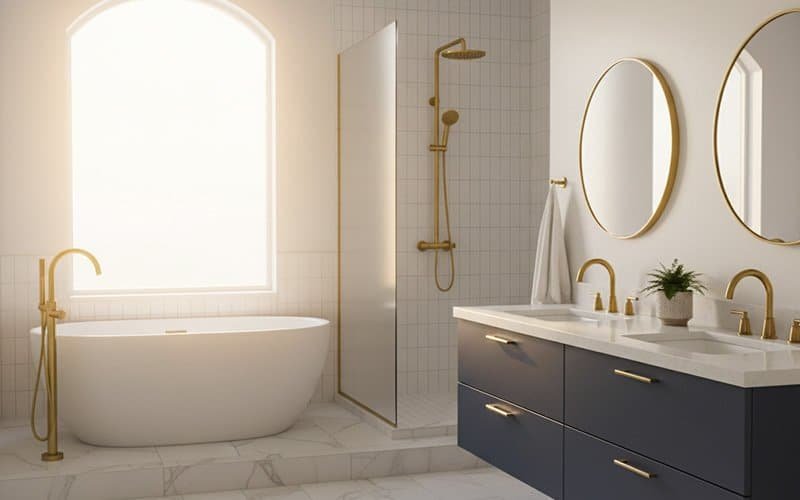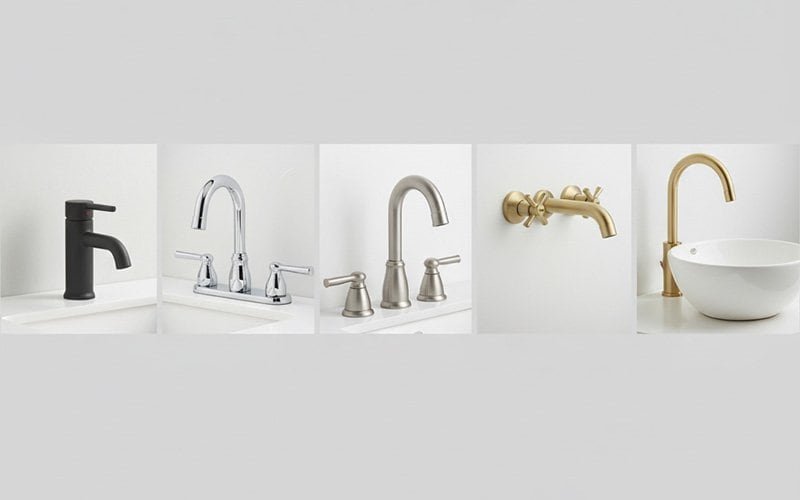Table of Content
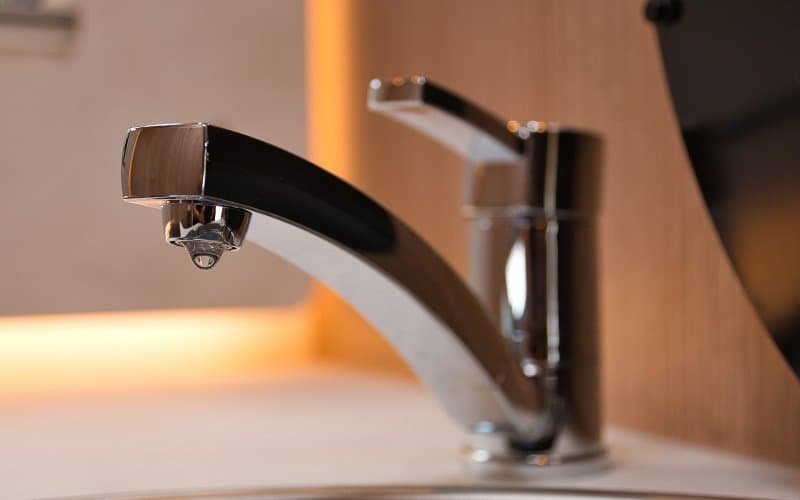
DIY Repair Disclaimer:
This guide is for general informational purposes only. Plumbing repairs can be complex and carry the risk of property damage or personal injury if done incorrectly. The steps provided are to be followed at **your own risk**. We assume no liability for any damages resulting from the use of this guide. We **strongly recommend consulting a licensed and insured professional plumber** for any complex or persistent issues.
The Annoying Drip – Why Your Bathroom Faucet Water Pressure is Low
Is your bathroom faucet delivering a weak trickle instead of a steady stream? Low water pressure can be a frustrating issue. It’s not just an inconvenience; it can throw off a whole morning routine. If you’re wondering, “Why is my bathroom faucet water pressure low?” then you’ve come to the right place.
This guide will walk you through some of the most common culprits behind low faucet pressure and show you how to address many of them. We’ll start with a quick diagnostic, then dive into some common DIY fixes, and finally, help you understand when it’s time to call in a professional.
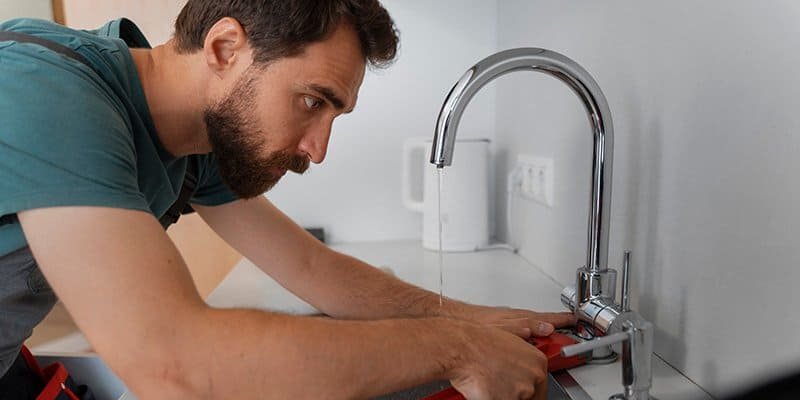
First Step: Is It Just One Faucet, or Your Whole Home?
Before you grab your toolbox, the very first thing we need to figure out is whether the low water pressure is isolated to just one bathroom faucet or if it’s a house-wide issue. This simple diagnostic step is crucial because it immediately narrows down the potential causes and tells us whether you’re dealing with a localized problem or something bigger.
Here’s a quick way to check:
- Test Other Faucets: Turn on other faucets in your home – in the kitchen, other bathrooms, even an outdoor hose spigot. Is the pressure low everywhere, or just in that one bathroom faucet?
- Compare Hot and Cold: At the problematic faucet, check if both hot and cold water have low pressure, or if it’s just one side
Interpreting Results:
- If it’s just one faucet (or just the hot/cold side of one faucet): This indicates the problem is likely localized to that specific fixture or its immediate supply lines. These are often issues that can be addressed with DIY methods, which we’ll tackle next.
- If it’s low pressure throughout your entire home: This suggests a more widespread issue, possibly with your main water supply, pressure regulator, or major pipe clogs. While some initial checks can be done, this usually warrants a professional plumber’s attention
Quick Troubleshooting Checklist
This table serves as a quick, at-a-glance reference for you, summarizing the diagnostic process and recommended actions.
| Symptom | Possible Cause | Initial Action | When to Call Plumber |
|---|---|---|---|
| Low pressure at one bathroom faucet (both hot & cold) | Clogged aerator, blocked cartridge, partially closed angle stop, kinked supply line. | Check aerator, angle stops, supply lines. | If DIY fixes don’t work. |
| Low hot water pressure at one bathroom faucet (cold is fine) | Clogged hot water aerator, water heater issue (sediment, malfunction, leak). | Check hot water aerator, inspect water heater (visible leaks/valve). | If water heater issues persist or are complex (e.g., sediment flushing, internal repair). |
| Low cold water pressure at one bathroom faucet (hot is fine) | Clogged cold water aerator, blocked cartridge, partially closed angle stop, kinked supply line. | Check cold water aerator, angle stops, supply lines. | If DIY fixes don’t work. |
| Low pressure at all faucets in the house (hot & cold) | Main water supply issue, PRV problem, hidden leak, municipal issue, peak usage, corroded pipes. | Check PRV, look for visible leaks, ask neighbors/building management. | Immediately for whole-house issues, PRV problems, suspected main line clogs, or old corroded pipes. |
| Low pressure at all hot water faucets in the house (cold is fine) | Water heater issue, main hot water line clog. | Inspect water heater (visible leaks/valve). | If water heater issues are complex or you suspect a main hot water line clog. |
| High water bill, mold, slow drains (anywhere) | Hidden leak | Check water meter for changes, look for visible signs of dampness/mold. | Immediately for suspected hidden leaks. |
| No water at all | Main water shut-off valve closed, municipal outage, main line break. | Check main shut-off valve, look for municipal notices. | If main shut-off is open and no municipal issue or notices. |
DIY Fixes: Simple Solutions for Low Faucet Pressure
If you’ve determined your low water pressure is likely a localized issue with your bathroom faucet, you may be able to fix it with a few common household tools. Let’s review the steps.
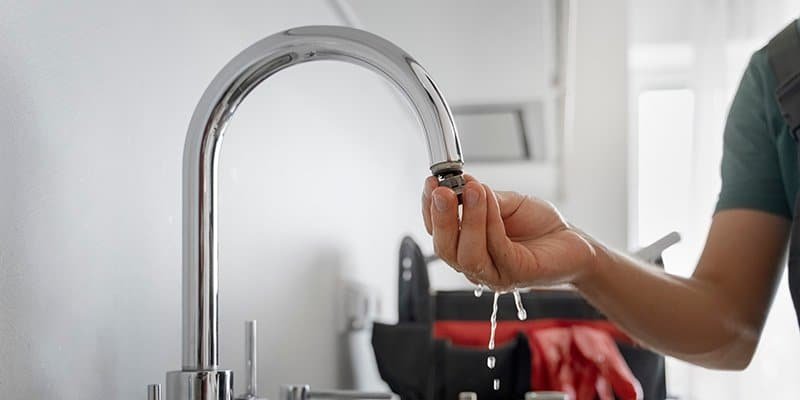
Clogged Aerator: Your First and Easiest Fix!
The aerator is that small, mesh screen located at the very tip of your faucet spout. Its job is to mix air into the water stream, making it feel softer and preventing splashing. Over time, mineral deposits (especially if you have hard water!) and sediment can build up on this screen, blocking water flow and causing that frustrating trickle
Here’s how to clean it:
- Remove the Aerator: Most aerators can be unscrewed counter-clockwise by hand. If it’s too tight, you might need a pair of pliers, but be sure to wrap a cloth around the aerator first to protect the finish from scratches. Some models might require a specialized tool – if it doesn’t turn easily, don’t force it!
- Inspect and Disassemble: Once removed, you’ll see several small parts: the screen, a washer, and sometimes a metal housing. Take note of the order they come apart so you can reassemble them correctly. Check for visible debris like mineral deposits (which can look like small rocks) or other gunk.
- Soak and Scrub: Place all the aerator parts in a bowl of white vinegar. Let them soak for a few hours, or even overnight, to dissolve mineral buildup. For stubborn debris, use an old toothbrush, a small pick, or a small screwdriver to gently scrub away any remaining gunk. Be careful not to damage the screen!
- Rinse and Reassemble: Rinse all parts thoroughly under clean water. Reassemble the aerator, making sure the washer is in place, and screw it back onto the faucet. Hand-tight is usually sufficient – no need to overtighten!
- Test: Turn on the water and test the flow. If this was the issue, you should notice a difference in pressure.

Blocked Faucet Cartridge: Diving a Little Deeper
If cleaning the aerator didn’t solve your problem, the next common culprit is a blocked faucet cartridge. This little component is located inside your faucet handle and is responsible for controlling the flow and temperature of the water. Over time, mineral buildup or debris can obstruct it, leading to reduced pressure.
Here’s how to clean or replace it:
- Turn Off Water Supply:
This is crucial! Locate the hot and cold water shut-off valves (also known as angle stops) under your sink and turn them fully clockwise until the water is off. Then, open the faucet to drain any remaining water. - Remove Faucet Handle:
Carefully remove the faucet handle. This usually involves prying off a decorative cap to reveal a screw (often a Phillips or Allen screw), which you’ll then unscrew. Some handles simply pull off after removing a set screw. - Access and Remove Cartridge:
Once the handle is off, you’ll see a retaining nut or clip holding the cartridge in place. Unscrew the nut or remove the clip, then gently pull the cartridge straight out of its housing. You might need pliers for a stubborn cartridge. - Clean or Replace:
Inspect the cartridge for any visible debris or mineral buildup. You can try soaking it in white vinegar overnight and scrubbing it with a brush, similar to the aerator. If it looks heavily damaged, cracked, or if cleaning doesn’t resolve the issue, it’s best to replace the cartridge with a new one that matches your faucet model. - Reassemble and Test:
Carefully reassemble all parts in reverse order, ensuring everything is secure. Turn the water supply back on slowly and check the faucet pressure. Remember to not overtighten the compression nut during reinstallation to avoid pipe damage.

Partially Closed Shut-Off Valves (Angle Stops): The Hidden Obstruction
Underneath your bathroom sink, you’ll find two small valves attached to the water supply lines – one for hot water and one for cold. These are called angle stops, and they allow you to turn off the water supply to just that faucet without affecting the rest of your home.
Sometimes, these valves get accidentally bumped or weren’t fully opened after a previous repair, restricting water flow.
Here’s how to check and open them:
- Simply reach under your sink and ensure both the hot and cold angle stop handles are turned fully counter-clockwise (the ‘on’ position).
If they’re only partially open, turn them all the way. If a valve handle just spins freely or won’t move at all, it’s likely broken and needs replacement – that’s a job for a professional!
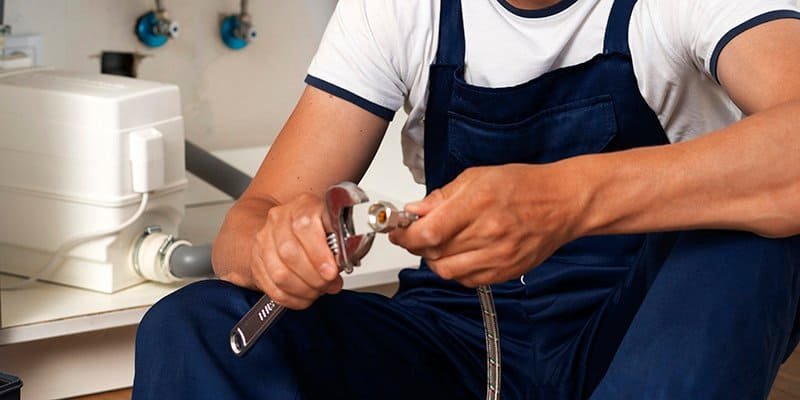
Kinked Water Supply Lines: A Quick Straighten
Sometimes, the flexible water supply lines connecting your faucet to the angle stops can get bent or kinked, especially if items under your sink have been moved around. A kink restricts water flow just like a pinched garden hose.
Here’s how to check and fix them:
- Carefully inspect both the hot and cold supply lines under your sink for any obvious bends or twists. If you find one, gently straighten it out. While you’re down there, it’s a great time to check for any leaks by placing a dry paper towel around the connections – if it gets wet, you’ve found a leak that needs attention!
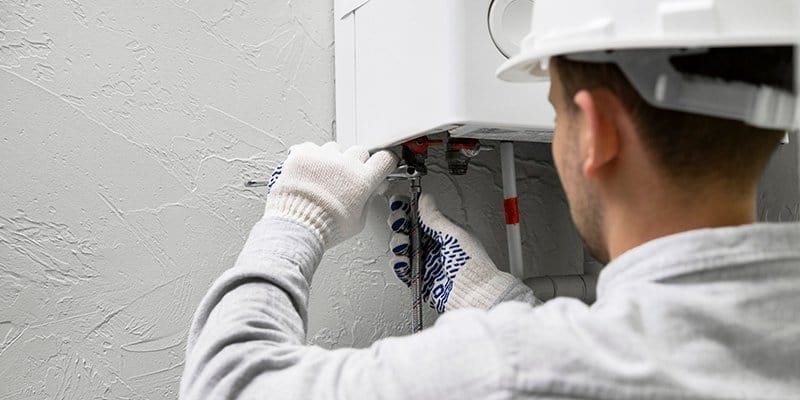
Low Hot Water Pressure Only? Check Your Water Heater!
If your cold water pressure is perfectly fine, but your hot water is barely trickling, the problem likely lies with your hot water supply system, most commonly your water heater.
Here’s what to check:
- Water Heater Shut-Off Valve: Just like the angle stops under your sink, your water heater has its own shut-off valve. Ensure it’s fully open.
- Sediment Buildup: Over time, sediment can accumulate in your water heater, especially at the bottom, and can restrict hot water flow. This is a more involved issue that often requires professional flushing or descaling.
- Water Heater Malfunction/Leak: A failing water heater or an internal leak can also lead to reduced hot water pressure.
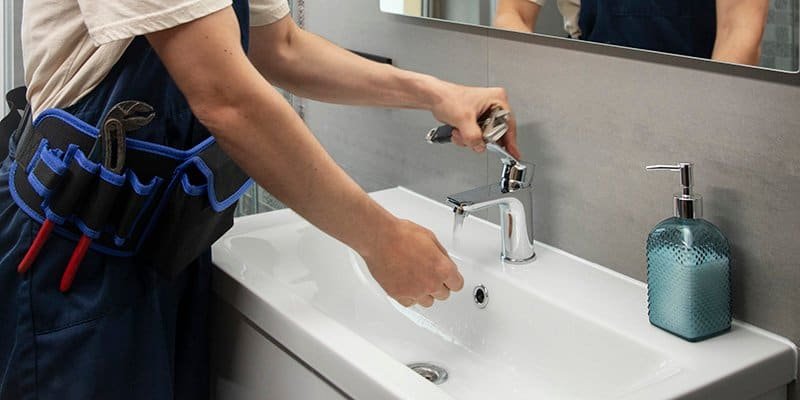
When to Call Your Plumber: Signs You Need a Professional Plumber
While many low water pressure issues can be resolved with a bit of DIY elbow grease, some problems are more complex and require the expertise of a licensed plumber.
Keeping Your Water Pressure Flowing Strong: Prevention Tips
Once you’ve got your water pressure back to normal, you’ll want to keep it that way! Here are a few simple tips from Rosana to help prevent future low water pressure headaches.
- Regular Aerator Cleaning: Make it a habit to unscrew and clean your faucet aerators every few months, especially if you live in an area with hard water. This simple maintenance can prevent most minor pressure drops.
- Flush Your Faucets: Periodically, remove your aerator and let the water run full blast for a minute or two. This can help flush out any loose sediment from the supply lines before it builds up.
- Consider a Water Softener: If you have hard water, mineral buildup is a constant battle. Installing a whole-house water softener can significantly reduce mineral deposits in your pipes and fixtures, extending their lifespan and maintaining pressure.
- Professional Plumbing Inspections: For older homes or if you’ve experienced recurring issues, consider a routine plumbing inspection by a licensed plumber. They can identify potential problems like corroding pipes or failing PRVs before they become major issues.
Conclusion: Enjoy Your Perfect Water Pressure
Low bathroom faucet water pressure can be a nuisance, but as we’ve seen, it’s often a fixable problem. Whether it’s a quick clean of the aerator or a deeper look into the cartridge, many solutions are within reach.
If you’re still struggling after trying these tips, or if you suspect a more serious issue, don’t hesitate to reach out to a licensed professional plumber for assistance.
Your Water Pressure Questions, Answered! (FAQ)
Related Posts



